COSTA DEL SOL
Population

Population

Popular destinations SPAIN
| Andalusia | Catalonia | Costa blanca |
| Costa brava | Costa del sol | El hierro |
| Formentera | Fuerteventura | Gran canaria |
| Ibiza | La gomera | La palma |
| Lanzarote | Mallorca | Menorca |
| Tenerife |
Population
General
No exact figures are known for the Costa Del Sol, but the population is around 1.5 million. Andalusia is one of the 17 autonomous regions of Spain. Andalusia has 8.6 million inhabitants (2024) and is therefore the largest Spanish autonomous region by population and good for approximately 20% of the Spanish population.
Andalusia just like Spain has a population density of approximately 96 people per km2. With almost 700,000 inhabitants, Seville is the fourth largest city in Spain and the largest city in Andalusia. Málaga is a close second with approx. 600,000.
Most Andalusians live in the big cities and on the tourist coastal region. The provinces of the same name have the greatest population density, the provinces of Córdoba and Granada are in the middle bracket, Jaén, Huelva and Almería are the least populated.
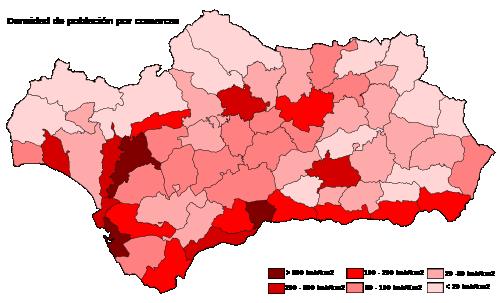 Population density overview Andalusia Photo: Té y kriptonita CC 3.0 Unported no changes made
Population density overview Andalusia Photo: Té y kriptonita CC 3.0 Unported no changes made
In the fifties and sixties of the last century, hundreds of thousands of Andalusians left the countryside of Andalusia to get recognition in the factories in the north of Spain and in Western European countries such as the Netherlands, Belgium and Germany. The 1970s saw the depopulation and aging of the rural areas of Andalusiaa due to the rapid rise of mass tourism, which provided many jobs in the coastal area. After the accession of Spain to the European Union in 1986, many Andalusians returned from abroad, but they too remained mainly in the big cities.
Population growth Andalusia 1787-2014
| 1787 | 1,850,157 |
| 1842 | 2,300,020 |
| 1860 | 2,965,508 |
| 1887 | 3,380,846 |
| 1900 | 3,544,769 |
| 1910 | 3,800,299 |
| 1920 | 4,221,686 |
| 1930 | 4,627,148 |
| 1940 | 5,255,120 |
| 1950 | 5,647,244 |
| 1960 | 5,940,047 |
| 1970 | 5.991.076 |
| 1981 | 6,440,985 |
| 1991 | 6,940,522 |
| 2001 | 7,357,558 |
| 2011 | 8.424.102 |
| 2014 | 8,500,000 |
Flamenco
Flamenco is a type of music with tight rhythm structures, combined with a dance, originating from the south of Spain, especially from Andalusia, but the provinces of Extremadura, Murcia and Huelva have also contributed to the development of (different types of) flamenco. Flamenco, with among others (African)-Arabic and many gypsy influences, originated in the second half of the 19th century and every new generation adds something new to it. About 40 different styles can be distinguished, from the popular 'fandango' to the gloomy 'siguiriya'.
The basis of flamenco is the singing, the 'cante flamenco', which in the past was usually accompanied with rhythmic 'knocking', for example clipping fingers, clapping hands, staccato stamping with feet or using castanets. Nowadays flamenco is usually accompanied by a Spanish flamenco guitar (el toque), but also sometimes by flute, violin, piano and cello. The singing is also supported by the typical flamenco dance (el baile). In recent decades flamenco has also been influenced by Latin American music and especially Cuban music. More recently, influences can be seen from world music and even from rock, punk and hip-hop.
Where the name flamenco comes from has never been resolved and many theories are circulating.
Flamenco music is divided into three categories: cante jondo (sad song) or cante grande, cante intermedio and cante chico. These three categories are subdivided into different forms, each with its own key and rhythm.
| FLAMENCO SHAPES | ||
| CANTE JONDO or GRANDE | CANTE INTERMEDIO | CANTE CHICO |
| soleares | tienos | alegrías |
| siguiryas | tarantas | bulerías |
| tonsás | tarantos | tanguillos |
| martinetes | peteneras | tangos |
| granainas | fandangos | |
| fandangos de Huelva | ||
| malagueñas | ||
| verdiales | ||
| farruca | ||
| garrotin | ||
| rumba |
The development of flamenco can be divided into a number of periods:
-1800-1860 'La Etapa Primitiva' or primitive period
-1860-1920 'La Etapa Clásica o de los Cafés Cantantes' or classical period
-1920-1950 'La Etapa de laÓpera Flamenca' or the period of flamenco opera
-1950-now 'La Etapa de Renacimiento' or period of the rebirth
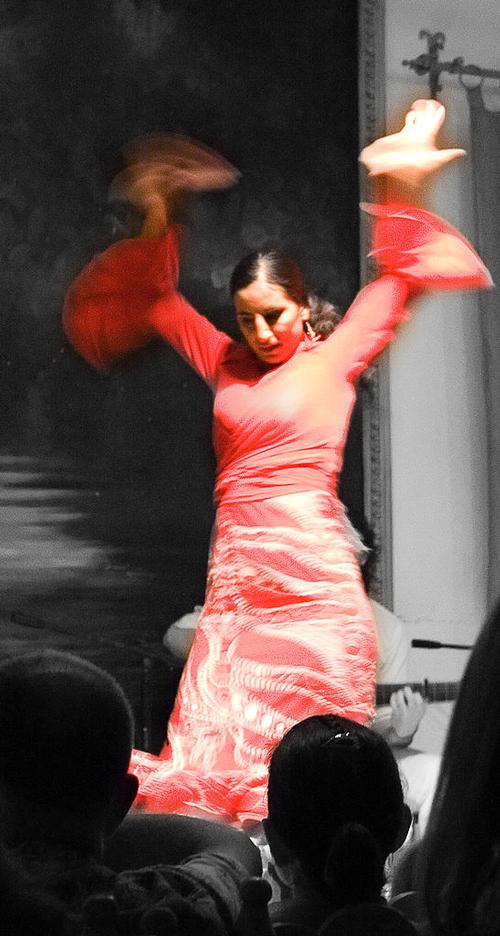 Flamenco dancer in traditional costume, Andalusia Photo: Michael Cohen CC 2.0 Generic no changes made
Flamenco dancer in traditional costume, Andalusia Photo: Michael Cohen CC 2.0 Generic no changes made
In Seville, there are the most and most varied possibilities to enjoy flamenco.
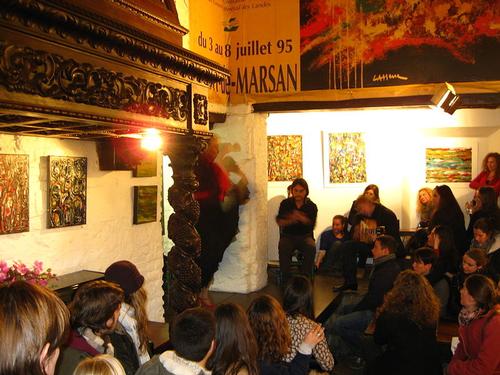 Typical flamenco tavern in SevillePhoto: Feranza CC 3.0 Unported no changes made
Typical flamenco tavern in SevillePhoto: Feranza CC 3.0 Unported no changes made
The greatest flamenco guitarist of the modern era was Paco de Lucía (1947-2014), born in the Andalusian Algeciras (province of Cádiz); one of the greats of the moment is Paco de Peña, born in Andalusian Córdoba. He ensured the popularization of flamenco, not only abroad but also in Spain itself. Together with the famous flamenco singer Camarón de la Isla (1952-1992) he developed the 'flamenco nuevo', a style variant of the flamenco guitar playing.
Another famous singer was Manuel Ortega Juárez (1909-1973), also known as Manolo Caracol or 'El Caracol'. At the moment the sisters Fernanda and Bernarda de Utrera are among the best flamenco singers; famous flamenco dancers or 'bailaoras' were Eva Yerbabuena, Sara Baras, Juana Amaya and the Seville-born Cristina Hoyos; important flamenco dancers or 'bailaors' are or were Antonio Canales and Joaquin Cortés.
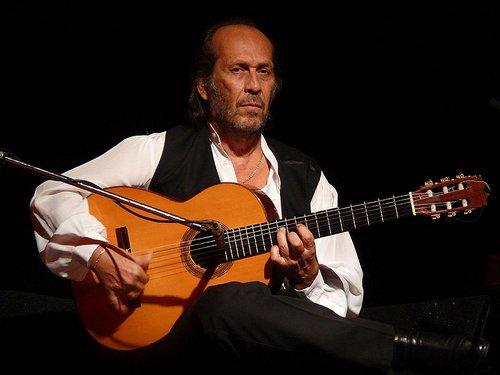 Francisco Sánchez Gómez (1947-2014), stage name Paco de LucíaPhoto: Cornel Putan CC 2.0 Generic no changes made
Francisco Sánchez Gómez (1947-2014), stage name Paco de LucíaPhoto: Cornel Putan CC 2.0 Generic no changes made
Language
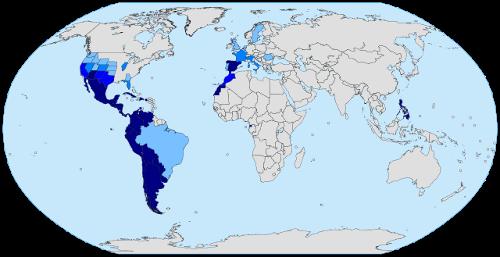 Spanish language mapPhoto: Michael Jester in the public domain
Spanish language mapPhoto: Michael Jester in the public domain
Castellano (Castilian) has been the official state language since around 1250. In other countries, Castellano is actually always called "Spanish". Castellano is a Romance language with many derivations from Latin, but also from many other languages. Spanish contains about 100 words that were brought to the peninsula by the Visigoths, among others. During the rule of the Moors, approximately 4000 words were introduced into the Spanish language. Furthermore, many words have been taken from French and Italian and more recently from English.
Examples of derivations are:
- Arabic. Alcázar. Aldea. Acequia. Alcoba
- French. monje. vinagre. menu. coqueta
- Western Gothic. guardia. ropa. tapa. espuela
- English. lider. mitin. tractor. fútbol
Castellano differs greatly from other Romance languages in some respects, especially in pronunciation. The letters of the Spanish alphabet are: a, b, c, ch, d, e, f, g, h, i, j, k, l, ll, m, n, ñ, o, p, q, r, rr, s, t, u, v, w, x, y, z.
The main dialects of Castellano are Andaluz, Leonés, Navarro, Aragonés and Asturiano.
In addition to Spain itself, Spanish is spoken in the Canary Islands and the enclaves of Melilla and Ceuta in Morocco. Furthermore, in all South American countries except Brazil, Guyana and Suriname; all Central American countries except Belize; the Caribbean islands of Cuba, Puerto Rico and the Dominican Republic; Philippines and Equatorial Guinea. In the United States, there are large Spanish-speaking communities (30 million) in Florida and California. In total, Spanish is spoken by more than 300 million people.
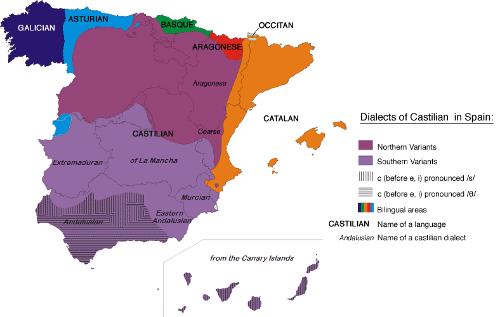 Spanish dialects mapPhoto: Stephen Shaw at the English Wikipedia CC 3.0 no changes made
Spanish dialects mapPhoto: Stephen Shaw at the English Wikipedia CC 3.0 no changes made
Important regional languages were not officially recognized until the 1978 constitution. In the Franco period it was even forbidden to speak Euskera, Gallego or Catalán.
In the Basque provinces, Basque, Vascuence or Euskera is the second official language. It is spoken on both sides of the Western Pyrenees by approximately 2.5 million people. Only a quarter of them still actually speak the language. Six deviating dialects can be distinguished and therefore a kind of standard Euskera has only been established since 1968, which is also used in official publications.
In Catalonia, Catalan or Catalán is the first official language. Catalán is a language that lies between French and Castellano and is spoken and understood by about six million people. The two main dialects of Catalán are Mallorquín and Valenciano.
Gallego or Galego is heavily influenced by Portuguese and is spoken by about 1 million people, including some in Portugal. Since Galicia is an autonomous province, all official documents are written in Spanish and Gallego.
The Gypsies or Rom normally speak Romani, a language related to Sanskrit. In Spain, Romani is mixed with Spanish and is called "Lengua Caló".
To clarify the differences between Castellano and Euskera, Gallego and Catalán, below is a sentence from the constitution about the language:
Castellano
El castellano es la lengua española oficial del Estado. Todos los españoles tienen el deber de conocerla y el derecho a usarla.
Euskera
Gaztelania da Espainiako Estatuaren hizkuntza ofiziala. Espainol guztiek jakin behar dute eta erabiltzeko eskubidea dute.
Gallego
O castelán é a lingua española oficial do Estado. Todos os españoles teñen o deber de coñecela e o dereito a usala.
Catalán
El castellà és la llengua espanyola oficial de l'Estat. Totally espanyols toes el door de conèixer-la i el dret d'usar-la.
A few words:
- English: Hey / Please / Thanks. Sorry
- Castellano: hola / por favor / gracias / perdón
- Euske: kaixo / mesedez / eskerrik asko / parkatu
- Gallego: ola / por favo / gracias / perdoa
- Catalán: hola / sisplau / gràcies / perdoni
Religion
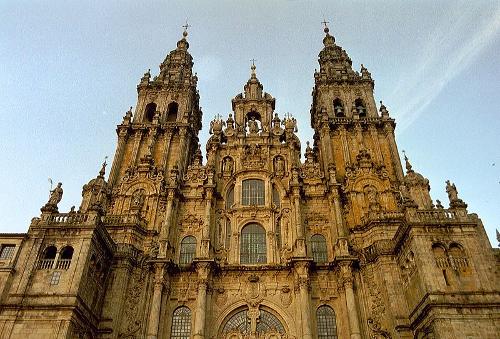 Cathedral of Santiago de Compostella, SpainPhoto: NielsB CC 3.0 Unported no changes made
Cathedral of Santiago de Compostella, SpainPhoto: NielsB CC 3.0 Unported no changes made
From the year 394, when Spain was still part of the Roman Empire, Roman Catholicism has been the state religion. It was Emperor Theodosius who took care of this. In 589 this status was reaffirmed by the Visigoth king Recaredo. In 711 Spain was conquered by the Moors and Islam was the main religion.
It was not until the early seventeenth century that the Catholic Church regained its powerful position and a close collaboration between church and state emerged. In 1931, at the time of the Second Republic, this undesirable situation came to an end. The church had become unpopular in all those centuries and this led to the death of about 6,000 clergymen in the Spanish Civil War. It was therefore not surprising that the church developed close ties with the Franco regime. Franco declared Roman Catholicism the state religion in 1939.
Thus church life was woven throughout society. It was very remarkable that the church was only allowed to appoint bishops on the recommendation of Franco. This close collaboration with the dictator made the church very unpopular among the population again. Although the Second Vatican Council demanded the separation of state and church, Franco refused to comply.
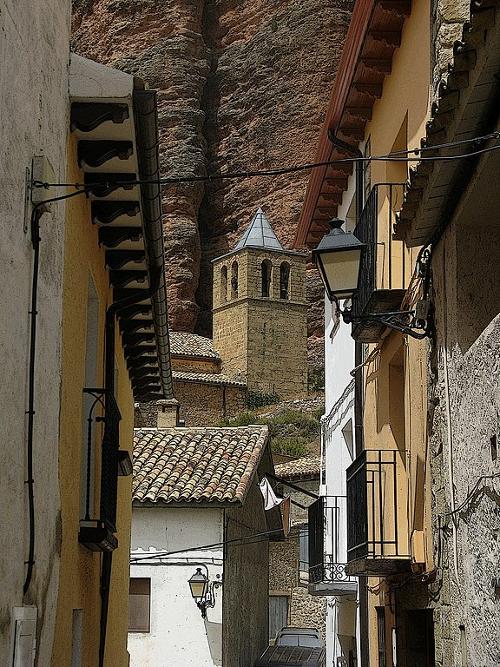 Village church SpainPhoto: Agracier-NO VIEWS CC 3.0 Unportedno changes made
Village church SpainPhoto: Agracier-NO VIEWS CC 3.0 Unportedno changes made
Only after Franco's death was the 1978 constitution reintroduced the separation of church and state and freedom of religion guaranteed. All this on the initiative of the newly appointed King Juan Carlos.
The Spanish population is approximately 95% Roman Catholic. The Roman Catholic Church comprises a total of 14 archdioceses and 53 dioceses. Together they form the eleven church provinces. The Archdioceses of Barcelona and Madrid-Alcalá fall directly under the Holy See of Rome. The primate of Spain is the Archbishop of Toledo. Approx. 870,000 people profess a faith other than Roman Catholicism, including Muslims (approx. 500,000), Jews and Protestants (approx. 70,000).
Involvement with the church has declined sharply in recent decades. More than 4 million people say they no longer adhere to any religion. The number of parish priests, monks and nuns is also declining sharply. Despite this decline, there is still massive participation in the important religious festivals. It is clear that at the moment it is more and more tradition instead of religious belief.
In the countryside there is a lot of participation in so-called "romerías", pilgrims / images to the shrine of a certain saint or to much revered images of Mary or Jesus. One of the best known is the Pentecostal romerías of Huelva, La Virgen del Rocío. Hundreds of thousands of pilgrims still flock here every year.
"Opus Dei"
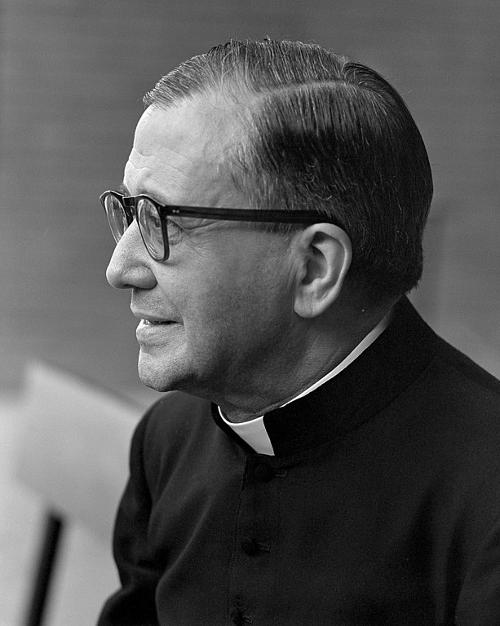 San Josemaría Escrivá, founder of Opus DeiPhoto: Oficina de Información de la Prelatura del Opus Dei en España cc-by-sa-2.0 no changes made
San Josemaría Escrivá, founder of Opus DeiPhoto: Oficina de Información de la Prelatura del Opus Dei en España cc-by-sa-2.0 no changes made
The organization "Opus Dei", also called "La Obra" in Spain, wants a better and more prosperous society, but strongly based on traditional Christian values. This organization was founded in 1928 by the priest Josemaria Escrivá de Balaguer whose maxims, the "Camino", published in 1931, serve as a guide for the supporters of the organization. He found that prosperity among the population was increasing, but that at the same time religiosity and secularisation increased.
Under the Franco regime, the movement had an increasing influence on social life, in 1941 on education and in 1957 even on the economy. The movement currently has about 80,000 members worldwide, of which about 27,000 are in Spain. With the canonization of Escrivá in 1998, Opus Dei has penetrated into the heart of the Roman Catholic Church.
A certain group, the "numerarios", live in communes and donate their incomes to the organization. This gives the organization a lot of money.
Obviously, these types of organizations receive a lot of criticism, the question of which is true. Opus Dei is also accused of taking people away from their own responsibility and people who disengage or want to disengage do not have an easy time. Furthermore, strict confidentiality is required of the members about internal affairs.
Sources
theworldofinfo.com/spain
Wikipedia
Oosterman, I / Costa Del Sol, Andalusië
CIA - World Factbook
BBC - Country Profiles
Copyright: Team The World of Info